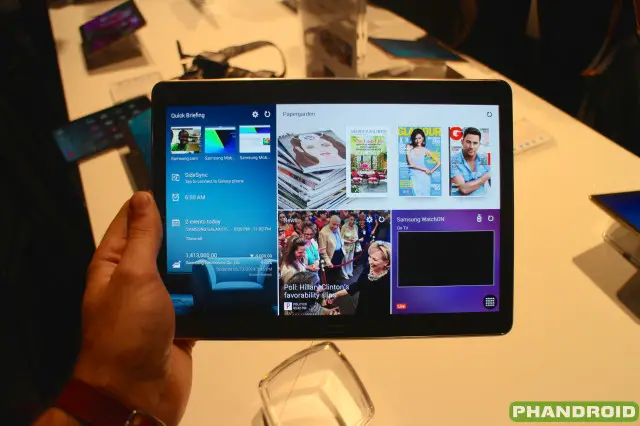Hands on: Samsung Galaxy Tab S
After years of Galaxy Tab this and Galaxy Tab that, Samsung has finally unified their flagship S lineup between smartphone and tablet with the introduction of the Galaxy Tab S. The device, available in 10.5 and 8.4-inch variants, is remarkably similar to the Samsung tablets that came before, but it offers enough refreshing features to feel new at the same time.
The first thing you will notice about the Tab S is it’s Galaxy S5-inspired design cues. It features a dimpled faux-leather back, that unmistakable home button, and all the essence of its smartphone counterpart. It also sports the same updated TouchWiz interface, but more on that later. The Galaxy Tab S is remarkably thin and light, measuring in at only 6.6mm thick regardless of screen size and weighing in 200 or 400 gram range depending on model. But this is still Samsung, and that means the build still retains a flimsy quality thanks to its deployment of plastic as a primary material.
The big draw of the Tab S is its use of a Super AMOLED display at QHD resolution, and it’s about time we got this on a Samsung tablet. The Super AMOLED has been a staple of the Galaxy S lineup for years, and it fits right in with the Galaxy Tab. The Galaxy S5’s Super AMOLED display was praised as one of the best ever on a smartphone, and we get the feeling the same might be said of the Galaxy Tab S. The display does look pretty spectacular.
Is it as earth-shattering as Samsung made it sound in their launch presentation? We might question that a bit. It was interesting to see Samsung attempt to dress up Super AMOLED as a new, exciting technology despite the fact that some variation of it has been on the market for years. Samsung was also quick to point out the appeal of certain AMOLED features including bright, rich color saturation and deep contrast. In our experience, this can also be a weakness of the Super AMOLED, producing images that appear less realistic (albeit more visually stunning) than other displays.
But here the Super AMOLED does a fine job, as does a compliment of specs that Samsung didn’t spend a second of time overviewing on stage. This includes the presence of either an Exynos 5420 or Snapdragon 801 chipset (depending on region), 3GB RAM, and 8MP/2.1MP cameras.
Perhaps the most intriguing aspect of the Galaxy Tab S, however, was its SideSync capabilities. This feature not only allows the user to send and receive calls via their Galaxy S5 through the Galaxy Tab S, but it also allows them to remotely access and control their smartphone. In our hands-on time, the feature was easy to set up and worked remarkably well. It’s not a totally new concept, but the execution was impressive for Samsung.
If that’s not a killer feature, consider the pricing. The 10.5-inch Galaxy Tab S will retail for $499 while the 8.4-inch variant will start at $299, a familiar pricing that no doubt targets Apple’s 10-inch iPad Air and 8-inch iPad mini. Ultimately, the GalaxY Tab S, while introducing many new features, looked and felt like a typical Samsung tablet refresh — not bad, but not earth-shattering either.
